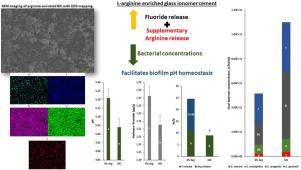Dental Materials ( IF 4.6 ) Pub Date : 2020-06-17 , DOI: 10.1016/j.dental.2020.05.012 Mohammed Nadeem Bijle 1 , Manikandan Ekambaram 2 , Edward C M Lo 3 , Cynthia Kar Yung Yiu 1

|
Objective
The study investigated the effect of incorporating l-arginine (Arg) in a glass ionomer cement (GIC) on its mechanical properties and antibacterial potential.
Methods
Pre-determined proportions (1%, 2%, and 4% by wt.) of Arg were incorporated in GIC powder; while GIC without Arg served as control. The flexural strength, nanohardness, surface roughness, elemental analysis using SEM-EDX (n = 6) and F/Arg/Ca/Al/Si release in deionized water for 21 days were assessed. The antibacterial potential was evaluated in a multi-species biofilm model with Streptococcus mutans, Streptococcus sanguinis, Streptococcus gordonii, and Lactobacillus acidophilus for 72 h. Real-time qPCR was used to analyse biofilm bacterial concentrations. Propidium monoazide modification of real-time qPCR was performed to quantify viable/dead bacteria. The pH, lactic acid, ADS activity, and H2O2 metabolism were measured. Confocal microscopy was used to investigate the biofilm bacterial live/dead cells, density, and thickness.
Results
There was no difference in flexural strength among the different groups (p > 0.05). No significant difference in nanohardness and surface roughness was observed between 4% Arg + GIC and control (p > 0.05). The 4% Arg + GIC showed significantly higher F/Arg/Al/Si release than the other groups (p < 0.05), reduced total bacterial concentration and growth inhibition of viable S. mutans and S. sanguinis (p < 0.05). Lactic acid formation for 4% Arg + GIC was significantly higher than 1% Arg + GIC (p < 0.05). The spent media pH of 4% Arg + GIC was higher than the other groups (p < 0.05), with proportionately lower ammonia and higher H2O2 released (p < 0.05).
Significance
Addition of 4% l-arginine in GIC enhanced its antibacterial activity via a biofilm modulatory effect for microbial homeostasis, with no detrimental effect on its mechanical properties.
中文翻译:

含精氨酸的玻璃离聚物水泥的抗菌和力学性能。
目的
该研究调查了将1-精氨酸(Arg)掺入玻璃离聚物水泥(GIC)中对其机械性能和抗菌潜能的影响。
方法
将预定比例(按重量计分别为1%,2%和4%)的Arg掺入GIC粉末中;而没有Arg的GIC作为对照。评估了去离子水中21天的抗弯强度,纳米硬度,表面粗糙度,使用SEM-EDX(n = 6)进行的元素分析以及F / Arg / Ca / Al / Si的释放。抗菌潜力在具有多物种生物膜模型中评估变异链球菌,血链球菌,链球菌戈登,和嗜酸乳杆菌72小时。实时定量PCR用于分析生物膜细菌浓度。实时qPCR进行了单叠氮化丙锭修饰,以定量活/死细菌。pH,乳酸,ADS活性和H 2 O 2测定新陈代谢。共聚焦显微镜用于研究生物膜细菌活/死细胞,密度和厚度。
结果
不同组之间的抗弯强度没有差异(p> 0.05)。在4%的Arg + GIC和对照组之间,没有观察到纳米硬度和表面粗糙度的显着差异(p> 0.05)。4%的Arg + GIC显示出比其他组显着更高的F / Arg / Al / Si释放(p <0.05),降低了总细菌浓度并抑制了变形链球菌和血链球菌的生长(p <0.05)。4%Arg + GIC的乳酸形成明显高于1%Arg + GIC(p <0.05)。4%Arg + GIC的废液pH值高于其他组(p <0.05),其中氨气成比例降低,而H 2 O 2释放量更高(p <0.05)。
意义
在GIC中添加4%的1-精氨酸可通过生物膜对微生物稳态的调节作用增强其抗菌活性,而对其机械性能无不利影响。











































 京公网安备 11010802027423号
京公网安备 11010802027423号